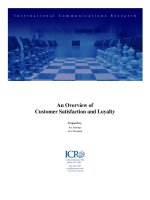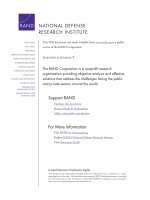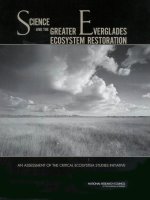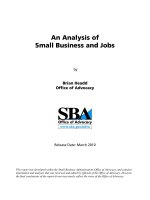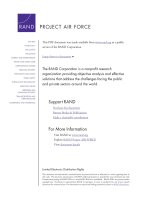An assessment of cameroons wind and solar energy potential a guide for a sustainable economic development
Bạn đang xem bản rút gọn của tài liệu. Xem và tải ngay bản đầy đủ của tài liệu tại đây (2.47 MB, 116 trang )
Bobbo Nfor Tansi
An Assessment of Cameroons
Wind and Solar Energy Potential
A Guide for a Sustainable Economic
Development
Diplomica Verlag
Bobbo Nfor Tansi
An Assessment of Cameroons Wind and Solar Energy Potential: A Guide for a
Sustainable Economic Development
ISBN: 978-3-8428-2028-9
Herstellung: Diplomica® Verlag GmbH, Hamburg, 2012
Dieses Werk ist urheberrechtlich geschützt. Die dadurch begründeten Rechte,
insbesondere die der Übersetzung, des Nachdrucks, des Vortrags, der Entnahme von
Abbildungen und Tabellen, der Funksendung, der Mikroverfilmung oder der
Vervielfältigung auf anderen Wegen und der Speicherung in Datenverarbeitungsanlagen,
bleiben, auch bei nur auszugsweiser Verwertung, vorbehalten. Eine Vervielfältigung
dieses Werkes oder von Teilen dieses Werkes ist auch im Einzelfall nur in den Grenzen
der gesetzlichen Bestimmungen des Urheberrechtsgesetzes der Bundesrepublik
Deutschland in der jeweils geltenden Fassung zulässig. Sie ist grundsätzlich
vergütungspflichtig. Zuwiderhandlungen unterliegen den Strafbestimmungen des
Urheberrechtes.
Die Wiedergabe von Gebrauchsnamen, Handelsnamen, Warenbezeichnungen usw. in
diesem Werk berechtigt auch ohne besondere Kennzeichnung nicht zu der Annahme,
dass solche Namen im Sinne der Warenzeichen- und Markenschutz-Gesetzgebung als frei
zu betrachten wären und daher von jedermann benutzt werden dürften.
Die Informationen in diesem Werk wurden mit Sorgfalt erarbeitet. Dennoch können
Fehler nicht vollständig ausgeschlossen werden und der Verlag, die Autoren oder
Übersetzer übernehmen keine juristische Verantwortung oder irgendeine Haftung für evtl.
verbliebene fehlerhafte Angaben und deren Folgen.
© Diplomica Verlag GmbH
, Hamburg 2012
Dedication
I dedicate this piece of work to my mother Juliana Tansi.
“Dear Juliana Tansi,
I just thought I'd drop you a line and tell you how much you mean to me. I know you
must think I just took your love for granted and I wanted to tell you that I am sorry
that I never told you before...
Thanks, Mom, for carrying me under your heart all these months, putting up with the
million and one things all expectant mothers just "go through"...
Thanks for enduring whatever degree of pain you went through to bring me into this
world. And Mom, I do appreciate you sitting up nights trying to figure out why I was
crying, after you did your best to keep me dry, fed, and comfortable... and the 5,000
diapers a year, thank you for each one of them... and the teeth cutting period... I must
have driven you out of your mind... I'm sorry.
Now, too many years later, I thank you and I'm sorry I caused you so much pain,
worry and headaches... and for all the sleep you lost. And Mom, thanks for all the
love, attention, guidance, patience, and yes, the discipline.
If I ever did anything to make you feel that you failed somewhere, don't blame
yourself. I had to find out some things on my own. I only pray I find the wisdom to do
as well with my children.
Thanks, Mom, for doing all the right things at the right time and most of all... for being
MY MOM.”
Acknowledgement
It takes a long time to write a master thesis, though not as long as it takes to lay some
rail track, surprisingly. I would here like to express my thanks to the people who have
been very helpful to me during the time it took me to write this thesis.
First, I thank my supervisors Prof. Dr. rer. nat. Jürgen Ertel and Prof. Dr. Michael
Scheffler, for their continuous support in the M. Sc. program. They were always there
to listen and to give advice. I will forever be grateful to Prof. Ertel, for his valuable
time that he devoted in correcting and guiding me during this time, and not only for
being there for my thesis, but also for inspiring me through his lectures, and guiding
me through my study project. The role of Prof. Scheffler in this direction of research
could also not be underestimated. He is responsible for involving me in the field of
renewable energy in the first place. He, alongside with Prof. Ertel, taught me how to
ask questions and express my ideas. They showed me different ways to approach a
research problem and the need to be persistent to accomplish any goal.
For this research, data were essential and collecting data is invariably a trying
experience. Data for this research could not be collected within the time frame
required for a master thesis. Hence, I would like to thank the following people and
institutions for their various support in making the data available for this study: NASA
for providing me with meteorological data for Cameroon, ARSEL Cameroon,
especially Etutu Shalman, for providing me with texts governing the energy sector in
Cameroon and finally CANMET for making available such a powerful software tool
as the RETScreen for free and also for their continues support and guidance through
emails when I got frustrated and stuck with the software. I would like to thank them
wholeheartedly. Without their generosity there would have been nothing to work with.
I am also greatly indebted to many teachers in the past: Mrs. Ngala Edith, Mr. Sama
Patrick (G.B.H.S Nkambe, Cameroon), Dr. Agyinge Christopher, Dr. Suh Emmanuel
and Dr. Njume Stephen (University of Buea, Cameroon) for getting me interested in
sciences and technology.
I owe a great deal to colleagues, students, friends and members of my class who have
helped extend my involvement in environmental sciences and renewable energy, and
i
who, through their own research, comments and questions have encouraged, supported
and enlightened me. Many thanks goes to my other friends especially Susi Hammel,
for being there for me and taking the time to read through my work and help cut the
‘T”s dot the “I”s which I did miss during the writing.
I would also like to thank heartily, Herr Jürgen Langer who facilitated my travelling to
Germany, and also supported me mentally, morally and financially during my studies.
His assistance cannot be underestimated because he is the reason I had the opportunity
to travel.
Last, but not the least, I thank my family: my mum and dad, Juliana and Henry, for
giving me life in the first place, for educating me with aspects from both arts and
sciences, for unconditional support and encouragement to pursue my interests, even
when these went beyond boundaries of language, field and geography; my sister
Felista Tansi, for sharing her experience of the dissertation writing endeavor with me,
for listening to my complaints and frustrations, and for believing in me; thanks also
goes to my elder sisters Joan Muyang Tansi and Maya Angelina Tansi, for endless
support and patience; my brothers Jimmy, George, Danilo, and Wilson, for reminding
me that my research should always be useful and serve good purposes for all
humankind.
Finally and most importantly, as one who believes in the misery surrounding the
existence of a supernatural being, I here thank God for everything he has done in my
life, - from my very existence, - to the mundane parts of my life, including breathing,
walking, thinking, communicating, and sensing, as well as my free will and the ability
to love. I thank God for all those things that he has provided in my life, not only my
basic needs but some of my wants as well.
ii
Abstract
Cameroon has vast renewable energy resource potentials, with a hydropower potential
of about 55,200MW, second only to the Democratic Republic of Congo in Africa. So
far, its energy needs are met by 4.8% hydropower (which accounts for less than 5% of
its total hydropower potential), 0% wind and 0% solar. Cameroons’ energy sector still
goes through insufficient electrical energy production, especially during the heart of
the dry season, which runs from December through March. Coincidentally, the wind
and solar power potentials for Cameroon are at their peak during these months and
could conveniently supplement for the shortfalls in generation during these periods.
In this research, technical analysis were carried out to determine the wind and solar
energy resource potentials for Cameroon using the RETScreen software tool provided
by CANMET Canada. These analysis revealed that the northern regions of Cameroon
had higher wind and solar resource potentials than any other location in Cameroon. A
2MW installed wind energy capacity would be capable of generating well over
1.5GWh electrical energy per year, while a 2KW installed solar energy capacity will
be capable of generating well over 3MWh electrical energy per year.
In the final sections, financial analysis were carried out to determine the economic
viability of such projects and the possibility for self-financing. Emission analyses were
also done based on the ability for such projects to offset greenhouse gas emissions and
ensure sustainability in the energy sector. The analysis for Maroua revealed that
78.6tCO2/yr for wind and 0.1tCO2/yr for solar could be reduced by those installations.
Finally, the legislations and legal frameworks governing the energy sector in
Cameroon were dissected to determine possible weaknesses and constraints limiting
the use, promotion and development of the full potential of Cameroon’s renewable
energy resources.
iii
Acronyms/Abbreviations
-
AES SONEL National Electricity Company, Cameroon
-
ALUCAM Aluminium Smelter Plant, Cameroon
-
ARSEL Electricity Sector Regulatory Agency, Cameroon.
-
CANMET Canada Centre for Mineral and Energy Technology
-
CBA Cost Benefit Analysis
-
CDM Clean Development Mechanism
-
CO2 Carbon Dioxide
-
CRC Carbon Reduction Commitment
-
DTIE UNEP’s Division of Technology, Industry and Economics
-
EEDRB Energy and Environmental Data Reference Bank
-
EEF The Energy and Environment Foundation
-
EIA US Energy Information Administration
-
FCFA Central African Franc
-
GDP Gross Domestic Product
-
GEF Global Environment Facility
-
GHG Greenhouse Gases
-
GW Gigawatt
-
GWh Gigawatt Hour
-
IAEA International Atomic Energy Agency
-
IEA International Energy Agency
iv
-
kWh Kilowatt Hour
-
MWh Megawatt Hour
-
NASA National Aeronautics and Space Administration
-
NGO Non-governmental Organization
-
NRCan Natural Resources Canada
-
OECD Organisation for Economic Co-operation and Development
-
PCF World Bank's Prototype Carbon Fund
-
PV Photovoltaic
-
R&D Research and Development
-
RE Renewable Energy
-
REEEP Renewable Energy and Energy Efficiency Partnership
-
RETs Renewable Energy Technologies
-
SONARA National Oil Refining Company, Cameroon
-
SWERA UNEP lead Solar and Wind Energy Resource Assessment Program
-
UNEP United Nations Environment Program
-
UNFCCC United Nations Framework Convention on Climate Change
-
WB World Bank
-
WCED World Commission on Environment and Development
v
List of Figures
Figure 1-1: Map of Cameroon ........................................................................................ 1
Figure 1-2: Share of Total Primary Energy Supply in Cameroon 2005 ......................... 4
Figure 3-1: RETScreen's Five Step Analysis................................................................ 18
Figure 4-1: Map View of Locations Used for Technical Analysis ............................... 21
Figure 4-2: RETScreens' Start worksheet showing project information. ..................... 34
Figure 4-3: RETScreens Energy Model Worksheet. .................................................... 35
Figure 4-4: RETScreen's Tools Worksheet. ................................................................. 36
Figure 4-5: Graph of Average Annual wind speeds for various locations used. .......... 37
Figure 4-6: Mean monthly wind speeds in Cameroon (10m above ground) ................ 38
Figure 4-7: Cross Section of a Wind Turbine. .............................................................. 39
Figure 4-8: ENERCONS E-82 Wind turbine. .............................................................. 40
Figure 4-9: Average annual solar radiation for locations used ..................................... 48
Figure 4-10: Monthly solar radiation values for Garoua .............................................. 48
Figure 4-11: BP's SX3200 Solar Module. .................................................................... 49
Figure 5-1: Cumulative cash flow graph for Maroua (wind assessment). .................... 63
Figure 5-2: Cumulative cash flow graph for Garoua (wind assessment). .................... 64
Figure 5-3: Cumulative cash flow graph for Ngaoundéré (wind assessment). ............ 65
Figure 5-4: Cumulative cash flow graph for Garoua (Solar). ....................................... 68
vi
List of Tables
Table 4-1: Locations used for analysis. ........................................................................ 20
Table 4-2: Site reference and climate data for Maroua ................................................ 22
Table 4-3:Site reference and climate data for Garoua. ................................................. 23
Table 4-4: Site reference and climate data for Ngaoundéré. ........................................ 24
Table 4-5: Site reference and climate data for Bamenda.............................................. 25
Table 4-6: Site reference and climate data for Bafia. ................................................... 27
Table 4-7: Site reference and climate data for Yaoundé. ............................................. 28
Table 4-8: Site reference and climate data for Douala ................................................. 30
Table 4-9: Site reference and climate data for Bertoua. ............................................... 31
Table 4-10: Site reference and climate data for Ebolowa............................................. 32
Table 4-11: Site reference and climate data for Fontem............................................... 33
Table 4-12: Power curve data for wind turbine ............................................................ 41
Table 4-13: Wind analysis results................................................................................. 43
Table 4-14: Monthly assessment results - Maroua ....................................................... 43
Table 4-15: Monthly assessment results - Garoua........................................................ 44
Table 4-16: Monthly assessment results - Ngaoundéré. ............................................... 45
Table 4-17: Monthly assessment results - Bamenda .................................................... 46
Table 4-18: Solar analysis results. ................................................................................ 51
Table 4-19: Monthly assessment results - Maroua (Solar)........................................... 52
Table 4-20: Monthly assessment results - Garoua (Solar)............................................ 52
Table 4-21: Monthly assessment results - Ngaoundéré (Solar)................................... 53
Table 4-22: Monthly assessment results - Bamenda (Solar) ........................................ 53
Table 4-23: Monthly assessment results - Bafia (Solar)............................................... 54
Table 4-24: Monthly assessment results - Yaoundé (Solar)......................................... 54
Table 4-25: Monthly assessment results - Douala (Solar)............................................ 55
Table 4-26: Monthly assessment results - Bertoua (Solar)........................................... 55
Table 4-27: Monthly assessment results - Ebolowa (Solar) ......................................... 56
Table 4-28: Monthly assessment results - Fontem (Solar) ........................................... 56
Table 5-1: Total initial costs of power projects. ........................................................... 60
vii
Table 5-2: Financial parameters, wind analysis............................................................ 62
Table 5-3: Financial paramters, solar analysis.............................................................. 67
Table 5-4: Financial analysis results and viability assessment - Solar resource. ......... 69
Table 6-1: GHG emission rates in Cameroon............................................................... 71
Table 6-2: GHG offsets by wind for Garoua and Ngaoundéré..................................... 73
Table 6-3: GHG offsets by solar for selected locations................................................ 74
viii
Table of Contents
Chapter 1 : Introduction .............................................................................................. 1
1.1 The Republic of Cameroon.................................................................................... 1
1.2 The Climate of Cameroon and Surface Meteorology ........................................... 2
1.3 The Energy Situation in Cameroon ....................................................................... 2
1.4 Renewable Energy................................................................................................. 4
1.5 Overview of Cameroon’s Renewable Energy Resources...................................... 5
1.5.1 Hydropower..................................................................................................... 6
1.5.2 Biomass ........................................................................................................... 6
1.5.3 Wind ................................................................................................................ 6
1.5.4 Solar ................................................................................................................ 7
Chapter 2 : Aims and Objectives................................................................................. 8
2.1 Rationale of the Study ........................................................................................... 8
2.2 Aims and Objectives of the Research.................................................................... 9
2.3 Thesis Outline...................................................................................................... 10
Chapter 3 : Methodology ........................................................................................... 12
3.1 Introduction ......................................................................................................... 12
3.2 Literature Review ................................................................................................ 12
3.3 RETScreen 4 International .................................................................................. 14
3.3.1 RETScreen Objectives................................................................................... 15
3.3.2 Software and Data ........................................................................................ 16
3.3.3 RETScreen 4 Features .................................................................................. 17
3.3.4 RETScreen’s Five Step Analysis ................................................................... 18
Chapter 4 : Technical Analysis.................................................................................. 20
4.1. Introduction ........................................................................................................ 20
ix
4.1.1 Far North Region - Maroua.......................................................................... 21
4.1.2 North Region – Garoua................................................................................. 22
4.1.3 Adamawa Region – Ngaoundéré................................................................... 23
4.1.4 North West Region – Bamenda ..................................................................... 24
4.1.5 West Region – Bafia ...................................................................................... 25
4.1.6 Centre Region – Yaoundé ............................................................................. 27
4.1.7 Littoral Region - Douala............................................................................... 29
4.1.8 Eastern Region – Bertoua ............................................................................. 30
4.1.9 South Region – Ebolowa ............................................................................... 31
4.1.10 South West Region – Fontem ...................................................................... 32
4.2. Central-grid Connected 2,000kW Wind Energy ................................................ 37
Results and Discussions. ........................................................................................... 43
4.3 Isolated-grid Connected 2,000W Solar Energy................................................... 47
Results and Discussions ............................................................................................ 51
Chapter 5 : Economic and Sustainability Analysis ................................................. 58
5.1 Introduction ......................................................................................................... 58
5.2 Renewable Energy and Economic Development. ............................................... 58
5.3 Cost Analysis....................................................................................................... 59
5.4 Financial Analysis ............................................................................................... 61
5.4.1 Wind .............................................................................................................. 62
5.4.2 Solar .............................................................................................................. 66
Chapter 6 : Environmental Analysis......................................................................... 70
6.1 Introduction ......................................................................................................... 70
6.2 Greenhouse Gas Emissions in Cameroon ........................................................... 71
6.3 Offsetting Greenhouse Gases by Wind ............................................................... 72
6.4 Offsetting Greenhouse Gases by Solar................................................................ 73
x
Chapter 7 : Political and Regulatory Framework ................................................... 75
Chapter 8 : Conclusion............................................................................................... 82
Chapter 9 : Recommendations .................................................................................. 85
References .................................................................................................................... 88
Appendix...................................................................................................................... 92
xi
Chapter 1 : Introduction
1.1 The Republic of Cameroon
The Republic of Cameroon is a Central African Nation. Originally part of the German
colony in West Africa, Cameroon became a republic in 1960. The country is in the
shape of an elongated triangle and forms a bridge between West and Central Africa. It
lies on the geographical coordinates of 6°N latitude and 12°E longitude. Cameroon
shares national borders to the west with Nigeria and Equatorial Guinea. To the east,
Cameroon shares borders with Tchad, the Central African Republic, and the Republic
of Congo. To the south, Cameroon is bordered by Gabon, Equatorial Guinea and the
Republic of Congo. (Figure 1-1). Cameroon is divided into 10 regions namely, Far
North, North, Adamawa, North west, West, Centre, East, South, Littoral and South
West Regions.
Figure 1-1: Map of Cameroon
Source: />
1
Cameroon has a population of 16.32million inhabitants and a growth rate of about
2.02% (IERN, 2009). The human population of Cameroon is very unevenly distributed
with an estimated population density of 34.45 persons per square kilometer (IAEA,
2005). Some areas of the country have populations exceeding 100 persons per square
kilometer. The human population density in some parts of the country especially to the
southeast, is very low: approximately below 1 person per square kilometer (IERN,
2009). According to the IEA, Cameroon has a total surface area of 63,701 square
kilometers.
1.2 The Climate of Cameroon and Surface Meteorology
Cameroon has a tropical climate – humid in the south, but increasingly dry towards the
north. Along the coast, the average annual rainfall is about 4,060mm. In the semiarid
northwest, annual rainfall measures about 380mm. A dry season in the north lasts from
October to April. The average temperature in the south is 25°C, on the plateau it is
21°C and in the north it is 32°C (maps of world, 2009). Cameroon has mean annual
hours of sunshine per year of over 3000 hours and an average solar radiation intensity
of 240W/m² (IEA, NASA). In the sunny part of the country, the average solar
irradiance is estimated at 5.8kWh/day/m², while it is 4.9kWh/day/m² in the rest of the
country.
1.3 The Energy Situation in Cameroon
“Energy in Cameroon plays a pivotal role in shaping the economy of the country. With
reserves of oil and natural gas, Cameroon is following new policies to improve and
develop the sources of energy. A rise in global competition has led to the expansion of
the energy sector in Cameroon. Energy in Cameroon comprises of its oil and natural
gas reserves, hydroelectric energy etc. The major energy sources of Cameroon include
fuel wood, Hydropower and petroleum.
Cameroon began offshore oil production in 1977. Annual production has gradually
fallen since 1985, and the decline is expected to continue as existing reserves are
depleted. Output amounted to 76,600 barrels per day in 2001, down from 100,000
barrels per day in 1999. However, as of 2002, Cameroon was still sub-Saharan
2
Africa's fifth-largest crude oil producer. Hydroelectric energy is one of the major
energies in Cameroon. Cameroon currently relies heavily on hydro power for its
energy. Electrical energy is produced mostly by two major hydroelectric stations
located on the Sananga river. Nearly 60% of the power from these stations goes to the
aluminum smelter at Edéa ALUCAM. Cameroon's installed electrical capacity was
819,000 kW in 2001; total production of electricity in 2000 was 3.5 billion kWh, of
which 97.4% was from hydropower and the remainder from fossil fuels. Consumption
amounted to 3.4 billion kWh in 2000” (Encyclopedia of the nations, 2009). The energy
sector of Cameroon, is presently undergoing a smooth and steady development that
helps to attract foreign investors, but the current situation is not good enough to
prevent frequent power outages.
According to the IEA, the energy consumption of Cameroon is estimated at
3,490GWh. At present, 4.8% of its power needs are met by hydropower, 78% from
biomass and the rest is generated from oil (Figure 1-2). Technical data from AES
SONEL (the sole company in Cameroon responsible for generating, transmitting and
distributing electrical energy) factsheet 2009, indicates an installed electricity capacity
of 229MW including a 206 MW of thermal energy. AES SONEL generates 3,685GWh
electrical energy annually, 2,799 GWh of which is sold to the public. AES SONEL has
an access rate of 15%, including just 4% in rural areas. The rate of coverage of the
country is 46%, with 20 agencies and 117 offices serving a total of 553,186
subscribers. AES SONEL has a total of 43 electricity generation facilities, generating
95% hydroelectricity and 5% conventional thermal energy. These facilities constitutes:
-
3 hydropower plants (Songloulou 400 MW, daily modulation basin, Edea, 265
MW, run-of river power plant and Lagdo, 72 MW, head reservoir)
-
3 dam- reservoirs for regulating River Sanaga: Bamendjin, Mbakaou, Lagdo,
with a total of 7.3 Gm3
-
6 diesel thermal power plants connected to networks: Oyomabang, Bassa,
Logbaba, Bafoussam, Limbe, and Djamboutou and
-
31 isolated power plants.
Energy generated from these plants is transmitted across the country in two separate
networks: the northern network, powered by the Lagdo (80Mva) hydropower plant and
3
the Djamboutou (17Mva) diesel thermal power plant, and the southern grid is powered
by the hydropower plants of Songloulou (456Mva) and Edéa (275Mva) and 4 thermal
power plants: Oyomabang (40Mva), Bassa (25MVa) Logbaba (20Mva) and
Bafoussam (16MVa).
Figure 1-2: Share of Total Primary Energy Supply in Cameroon 2005
Source: IEA Energy statistics, www.iea.org/statistics/index
1.4 Renewable Energy
Renewable energy is energy generated from natural resources such as sunlight, wind,
rain, tides, and geothermal heat, which are renewable (naturally replenished)
(Wikipedia, 2009). In 2006, about 18% of global final energy consumption came from
renewables, with 13% coming from traditional biomass, such as wood-burning and 3%
from hydroelectricity. New renewables (small hydro, modern biomass, wind, solar,
geothermal, and biofuels) accounted for 2.4% and are growing very rapidly. The share
of renewables in electricity generation is around 18%, with 15% of global electricity
coming from hydroelectricity and 3.4% from new renewables (REN21, 2007).
Advantages and Benefits of Renewable Energies (ICRE, 2004)
-
Renewable energy (RE) presents a more sustainable alternative to the use of
finite sources of energy.
-
They reduce the reliance on energy imports and diversify energy supply mixes
by making use of locally available resources, thus contributing to energy
security.
4
-
Renewable resources possess the inability to emit carbon-based warming and
polluting agents into the atmosphere.
-
As REs have low to zero greenhouse gas emissions, they reduce human-induced
climate impacts.
-
REs help to reduce negative health impacts from airborne emissions.
-
In industrialized countries, renewables have already spurred the development of
new industries and services for planning, manufacturing, operating and
maintenance and
demonstrated their potential to create highly qualified
employment in new small and medium-sized enterprises. They can create
decentralized markets and contribute to local economic development by
introducing new capital and innovation and by developing new sources of
revenue for local communities in the developing world too.
In spite of all these advantages, renewables are usually found to be more expensive
than conventional electricity sources when compared on a financial cost basis. Because
of this, both monopoly and competitive electricity producers have concentrated their
investment on conventional electricity technologies, with renewables usually
accounting for only a small percentage of the generating stock (Berry and Jaccard,
2001).
There are three main reasons for the discrepancy between the social and economic
benefits of renewables and their high financial cost relative to conventional, polluting
generation sources (Berry and Jaccard, 2001) and these are:
-
Some jurisdictions provide subsidies to conventional generation sources.
-
The full costs of pollution (externalities) are not included in the financial cost of
conventional electricity sources.
-
Renewables are often associated with newer, higher cost technologies, whose
relative costs will fall in time with widespread commercialization because of
economies of learning and economies of scale in equipment manufacture.
1.5 Overview of Cameroon’s Renewable Energy Resources
Renewable energy resources are diverse and vary from country to country.
Cameroon’s known renewable energy resources are hydro, biomass, wind and solar.
5
1.5.1 Hydropower
Hydroelectric resources remain the most readily exploitable form of energy in
Cameroon, which, together with the Democratic Republic of Congo, is considered to
have the greatest hydroelectric potential in Africa. Electrical energy is produced
primarily by two hydroelectric stations on the Sananga River. In the 1980s,
hydroelectric capacity was expanded by an additional complex on the Sananga River
(Song-Loulou) and a 72 MW generator (built with Chinese aid) on the Bénoué.
Cameroon’s hydropower potential is estimated at 55,200MW and generates
294,000,000MWh per annum (294 TWh per annum) (Belda, 2007).
1.5.2 Biomass
Cameroon has the third largest biomass potential in sub-Saharan Africa. Biomass
forms the dominant source of energy accounting for 66.7% of the total national energy
consumption, with wood fuel being the dominant biomass form used in Cameroon.
Biomass is used in both domestic and commercial sectors for cooking and many other
heat applications. In this research, assessment of biomass energy resource potential in
Cameroon will not be discussed in detail.
1.5.3 Wind
Wind energy in Cameroon has never been studied thoroughly, a few attempts have
been made using wind speed data published by the Cameroonian meteorological
services. From these assessments, final conclusions could not be drawn as to the
possibilities of wind energy exploitation in the northern regions, but affirmatively,
these results revealed that the far northern regions of Cameroon was favorable for the
use of wind energy (Tchinda et al, 2000). Meteorological data from NASA, revealed
that the northern regions of Cameroon have annual mean wind speeds that are equal to
or exceed 3 m/s for over 80% of the time, and the Adamawa region has annual wind
speeds that are equal to or exceed 2 m/s for over 60% of the time, while the rest of the
country has wind speeds greater than or equal to 1m/s for over 50% of the time. In this
research, a detailed analysis of this energy resource is presented in chapter 4 (technical
analysis).
6
1.5.4 Solar
Cameroon being a tropical country is well endowed with solar energy resources,
receiving mean annual hours of sunshine per year of over 3000 hours and an average
solar radiation intensity of 240W/m² (IEA, 2009; NASA, 2009). Some important solar
energy resources are available throughout the country. In the sunny part of the country,
the average solar radiance is estimated at 5.8 kWh/day/ m² while it is 4.9kWh/day/ m²
in the rest of the country. Conditions therefore seem to be ideal throughout the country
for the exploitation of Cameroon’s solar energy resources through various conversion
technologies. Solar energy already makes substantial (although unquantified)
contributions to the nation’s energy supply. Traditional applications of solar energy in
Cameroon include sun drying of agricultural produce, fish, fuel wood and clothes. A
detailed assessment of this resource is presented in chapter 4 (technical analysis).
7
Chapter 2 : Aims and Objectives
2.1 Rationale of the Study
Power shortages in Cameroon have been a key constraint to its economic growth.
Cameroon has a total installed electricity production capacity of 935 MW, but the
country’s effective functioning productive capacity is, at present, only 450 MW (Fbo,
2008). This shortfall has been caused by various factors including among others; the
reliance on aged facilities and equipments, the effects of harsh climatic conditions, and
the lack of long term maintenance.
“Energy related threats such as the lack of sustainable secure and affordable energy
supplies, together with the environmental damage incurred in producing, transporting
and consuming energy, have been the main drive to the need for renewable energy
development. With a world’s population of 6 billion people heading to 11billion, rising
fuel costs, climate change concerns and the growing demand for electricity, renewable
energy is fast becoming an increasingly valuable solution for the global energy
problem.
The quest for energy has created greenhouse gases (GHG) emission problems which
have contributed greatly to global warming. Emissions of GHG such as carbon
dioxide, methane, and others, have increased dramatically in the last century through
fossil fuel burning and land use changes. Human activity has pushed atmospheric
concentrations of carbon dioxide, the chief greenhouse gas, to more than 30% above
pre-industrial levels, 370 parts per million today compared to about 280 in 1750
(CDIAC 2001). These increases have already brought changes to the Earth's climate.
Nine of the ten hottest years since 1860 (when temperature records began being kept)
occurred between 1990 and 2000. Continued accumulation of GHG is expected to lead
to rising temperatures, more severe weather events, increased ecosystem stresses,
shifting precipitation patterns, increased ranges of infectious diseases, coastal
flooding, and others impacts that we are only beginning to understand. These changes
will bring uncertain, but potentially devastating, consequences to communities around
the globe, both in the industrialized and developing worlds.
8
According to the Intergovernmental Panel on Climate Change (IPCC), the
authoritative scientific voice on climate change, without active efforts to reduce
emissions, the planet is expected to warm by an unprecedented 2.5 to 10o F during the
21st century. This rate of warming is much larger than the observed changes during
the 20th century and is very likely to be without precedent during at least the last
10,000 years.” (Earthtrends, 2001). Impacts of climate change are expected to be
severe. Taking unified global action against climate change, however, has proven
contentious. A shift from the use of natural gases and fossil fuel towards green and
renewable sources of energy is a big step to cutting the rate of GHG emissions.
Despite Cameroons vast renewable energy potentials, the performance of the power
sector in Cameroon since 2001 has been a disaster to its economy, going through
fluctuating and insufficient power generations. The sole dependence on hydropower
for electricity in Cameroon has significantly contributed to its energy problems with
increasing climatic changes leading to severe and prolonged draughts during the dry
season in Cameroon which runs between November and April. The majority of people
in Cameroon use biomass as their primary energy source (Figure 1-2), due in large to a
lack of electricity accessibility.
2.2 Aims and Objectives of the Research
This research work attempts to evaluate the potential of wind and solar energy of
Cameroon. It tries to establish the state of the art of electricity generation, transmission
and distribution in Cameroon, the problems it faces and the inability to meet the
current energy demand for Cameroon. In addition, the research seeks to examine and
assess the renewable energy sector and the possibility to revitalize the energy sector in
Cameroon in an environmentally friendly way. The research further examines the legal
framework of Cameroon and other government initiatives in as much as energy and
electricity are concerned. It also considers the potential role of renewable energy,
especially wind and solar, in improving the performance of the energy and electricity
sector in Cameroon. Thus, the specific considerations and objectives of this study are
as follows:
9
